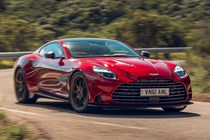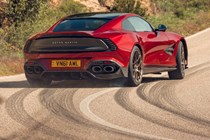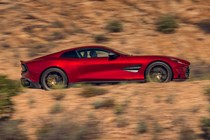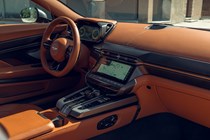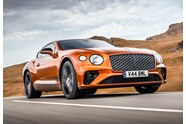Aston Martin Vanquish review

At a glance
| Price new | £339,545 |
|---|---|
| Used prices | £271,044 - £314,930 |
| Road tax cost | £620 |
Get an insurance quote with

|
|
| Fuel economy | 20.7 mpg |
| Miles per pound | 3.0 |
| Number of doors | 2 |
| View full specs for a specific version | |
Available fuel types
Petrol
Pros & cons
- Comfortable ride
- Luxurious interior
- Indecently fast
- Ruinously thirsty when you're pushing on
- Lazy throttle response
- Longer than a DB12, yet it loses two seats
Aston Martin Vanquish Coupe rivals
Overview
2024 sees the return of yet another well-loved boot badge, albeit one that’s a bit harder to come by than the norm. Like in 2012, the DBS has died so the Aston Martin Vanquish can be reborn with a new V12 and over 800hp. Electrification? Absolutely not, just like the rest of the best sports cars out there.
The Vanquish sits at the top of the conventional Aston Martin range, with limited run hypercars such as the Valkyrie sitting above it. It’s rear-wheel drive and comes exclusively with an automatic gearbox, with high-speed long-distance cruising its primary function.
Aston has made efforts to ensure you can have some fun on bendier roads, although it doesn’t quite have the tech available in the Ferrari 12Cilindri or Bentley Continental GT. Does that put the Vanquish at a disadvantage? To find out, I sadly had to fly to Sardinia for a bit of winter sun. Shame.
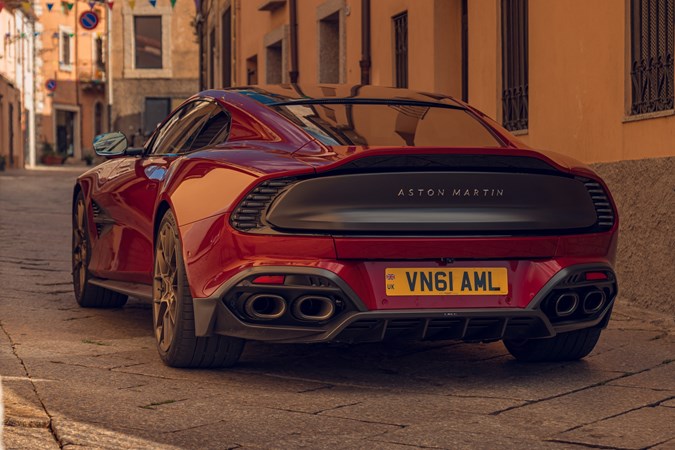
Keep reading to find out just how good the Vanquish is. If you’d like to know how I got to my verdict, check out our how we test cars page.
What’s it like inside?
Aston Martin interiors always used to be filled with rich materials and switchgear raided from various manufacturer’s parts bins. The outgoing DBS 770 was a prime example, with lots of decade-old Mercedes bits making the cabin feeling older and cheaper than it should.
Those days are long gone, with more secure financial backing bringing the cash for an almost entirely new interior. The supple leather, expensive-looking carbon fibre and thick carpets remain, but they’re joined by switches and buttons that feel just as premium.

You get plenty of physical controls and a far more user-friendly layout than Ferrari prefers. This includes normal light and wiper stalks, with far less being controlled via the steering wheel. The infotainment system is mounted quite low in the dash, although many of its functions can be shown in the digital driver’s display.
The displays look good and are pretty straightforward to navigate. It’s a shame the wheel-mounted touchpad for the driver’s display felt a bit wobbly, and the systems didn’t as work as snappily as I’d want at times. That said, it is a pre-production car so hopefully the issues will be resolved for customers.
Space up front is generous, with lots of adjustment for the seat and steering wheel. You don’t get a pair of rear seats, despite the Vanquish being longer than the 2+2 Aston Martin DB12. Even if you don’t want to carry passengers, they are a useful boost to carrying capacity.
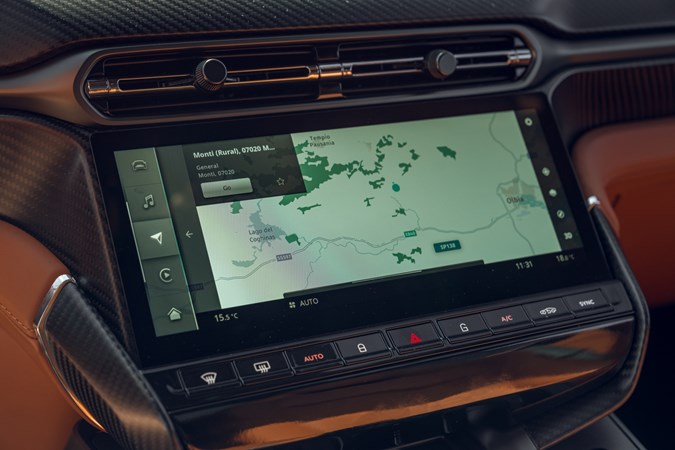
After all, a 248-litre boot isn’t awful for this rarified class, but it was full with a couple of carry-on suitcases and a larger bit of hold luggage. Oddment storage up front is sufficient, and bespoke fitted luggage for behind the rear seats is available.
Comfort
You get 16-way electrically adjustable heated seats as standard that offer excellent support for your back on long distances, and they hold you in place well when cornering hard, too. Ventilation for the seats is optional, or there’s a lighter Performance seat option with grippy Alcantara fabric.
The driving position is good, with enough adjustment to accommodate a wide variety of heights and sizes and controls that all line up well. All-in, you’d happily spend a few hundred miles here.

Safety
Euro NCAP doesn’t test high-end luxury stuff like the Vanquish, so don’t expect to see crash test scores any time soon. That much power does require a stiff structure that should make it a safe place in a crash.
You get plenty of tech to stop one happening in the first place. This includes automatic emergency braking, lane keep assist, blind spot monitoring, drowsiness detection and rear cross traffic assist. All this is standard equipment along with adaptive cruise and a 3D surround-view camera.
What’s it like to drive?
The Vanquish is a longer car than both the Vantage and DB12, with more distance between its front and rear axles to best accommodate the twin-turbo 5.2-litre V12. Power is a mighty 824bhp to give 0-62mph in 3.3-seconds and a 214mph top speed, although throttle response isn’t as crisp as in a DB12, let alone the Ferrari 12Cilindri.

Clever traction control does a great job of smoothly applying as much power as possible, but it’s not until third gear that all the reserves can be used because the Vanquish remains rear-wheel drive. Make no mistake, this is a properly fast car that can be best appreciated on a runway or derestricted stretch of autobahn.
Monumental performance doesn’t come at the expense of everyday drivability. The V12 is civilised at low speeds and the eight-speed automatic gearbox shuffles satisfactorily between ratios without fuss. Ride comfort is very impressive, soaking up all but the craggiest surfaces better than many executive cars I could mention and it cruises quietly, too.
You are aware of a little floatiness when pushing on, with Sport mode tightening body control whilst remaining supple over bumps. Sport+ stiffens things further and was appreciated at high speeds especially.

You can certainly have some fun with the Vanquish once the motorways become sinewy single carriageways. The steering has great precision and gives plenty of sensation from the front tyres, and the V12 sounds great in the mid-range. Push harder and it’s not quite as happy or as sharp as a DB12, feeling significantly lairier if you dare turn down the electronic assistants.
What models and trims are available?
Aston Martin doesn’t really do trim levels, you just pick your model then raid the options and personalisation lists. This can get very expensive, just like in rivals.
Click through to the next page to read our verdict on the Aston Martin Vanquish.


